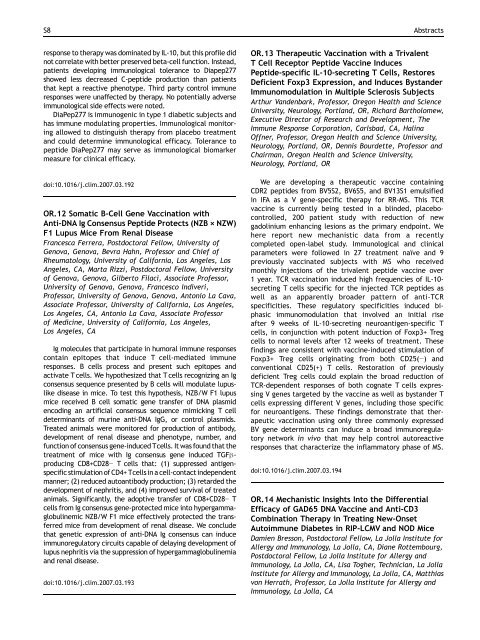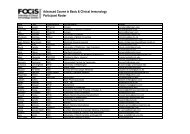Oral Presentations - Federation of Clinical Immunology Societies
Oral Presentations - Federation of Clinical Immunology Societies
Oral Presentations - Federation of Clinical Immunology Societies
Create successful ePaper yourself
Turn your PDF publications into a flip-book with our unique Google optimized e-Paper software.
S8 Abstracts<br />
response to therapy was dominated by IL-10, but this pr<strong>of</strong>ile did<br />
not correlate with better preserved beta-cell function. Instead,<br />
patients developing immunological tolerance to Diapep277<br />
showed less decreased C-peptide production than patients<br />
that kept a reactive phenotype. Third party control immune<br />
responses were unaffected by therapy. No potentially adverse<br />
immunological side effects were noted.<br />
DiaPep277 is immunogenic in type 1 diabetic subjects and<br />
has immune modulating properties. Immunological monitoring<br />
allowed to distinguish therapy from placebo treatment<br />
and could determine immunological efficacy. Tolerance to<br />
peptide DiaPep277 may serve as immunological biomarker<br />
measure for clinical efficacy.<br />
doi:10.1016/j.clim.2007.03.192<br />
OR.12 Somatic B-Cell Gene Vaccination with<br />
Anti-DNA Ig Consensus Peptide Protects (NZB × NZW)<br />
F1 Lupus Mice From Renal Disease<br />
Francesca Ferrera, Postdoctoral Fellow, University <strong>of</strong><br />
Genova, Genova, Bevra Hahn, Pr<strong>of</strong>essor and Chief <strong>of</strong><br />
Rheumatology, University <strong>of</strong> California, Los Angeles, Los<br />
Angeles, CA, Marta Rizzi, Postdoctoral Fellow, University<br />
<strong>of</strong> Genova, Genova, Gilberto Filaci, Associate Pr<strong>of</strong>essor,<br />
University <strong>of</strong> Genova, Genova, Francesco Indiveri,<br />
Pr<strong>of</strong>essor, University <strong>of</strong> Genova, Genova, Antonio La Cava,<br />
Associate Pr<strong>of</strong>essor, University <strong>of</strong> California, Los Angeles,<br />
Los Angeles, CA, Antonio La Cava, Associate Pr<strong>of</strong>essor<br />
<strong>of</strong> Medicine, University <strong>of</strong> California, Los Angeles,<br />
Los Angeles, CA<br />
Ig molecules that participate in humoral immune responses<br />
contain epitopes that induce T cell-mediated immune<br />
responses. B cells process and present such epitopes and<br />
activate T cells. We hypothesized that T cells recognizing an Ig<br />
consensus sequence presented by B cells will modulate lupuslike<br />
disease in mice. To test this hypothesis, NZB/W F1 lupus<br />
mice received B cell somatic gene transfer <strong>of</strong> DNA plasmid<br />
encoding an artificial consensus sequence mimicking T cell<br />
determinants <strong>of</strong> murine anti-DNA IgG, or control plasmids.<br />
Treated animals were monitored for production <strong>of</strong> antibody,<br />
development <strong>of</strong> renal disease and phenotype, number, and<br />
function <strong>of</strong> consensus gene-induced Tcells. It was found that the<br />
treatment <strong>of</strong> mice with Ig consensus gene induced TGFβproducing<br />
CD8+CD28− T cells that: (1) suppressed antigenspecific<br />
stimulation <strong>of</strong> CD4+ Tcells in a cell-contact independent<br />
manner; (2) reduced autoantibody production; (3) retarded the<br />
development <strong>of</strong> nephritis, and (4) improved survival <strong>of</strong> treated<br />
animals. Significantly, the adoptive transfer <strong>of</strong> CD8+CD28− T<br />
cells from Ig consensus gene-protected mice into hypergammaglobulinemic<br />
NZB/W F1 mice effectively protected the transferred<br />
mice from development <strong>of</strong> renal disease. We conclude<br />
that genetic expression <strong>of</strong> anti-DNA Ig consensus can induce<br />
immunoregulatory circuits capable <strong>of</strong> delaying development <strong>of</strong><br />
lupus nephritis via the suppression <strong>of</strong> hypergammaglobulinemia<br />
and renal disease.<br />
doi:10.1016/j.clim.2007.03.193<br />
OR.13 Therapeutic Vaccination with a Trivalent<br />
T Cell Receptor Peptide Vaccine Induces<br />
Peptide-specific IL-10-secreting T Cells, Restores<br />
Deficient Foxp3 Expression, and Induces Bystander<br />
Immunomodulation in Multiple Sclerosis Subjects<br />
Arthur Vandenbark, Pr<strong>of</strong>essor, Oregon Health and Science<br />
University, Neurology, Portland, OR, Richard Bartholomew,<br />
Executive Director <strong>of</strong> Research and Development, The<br />
Immune Response Corporation, Carlsbad, CA, Halina<br />
Offner, Pr<strong>of</strong>essor, Oregon Health and Science University,<br />
Neurology, Portland, OR, Dennis Bourdette, Pr<strong>of</strong>essor and<br />
Chairman, Oregon Health and Science University,<br />
Neurology, Portland, OR<br />
We are developing a therapeutic vaccine containing<br />
CDR2 peptides from BV5S2, BV6S5, and BV13S1 emulsified<br />
in IFA as a V gene-specific therapy for RR-MS. This TCR<br />
vaccine is currently being tested in a blinded, placebocontrolled,<br />
200 patient study with reduction <strong>of</strong> new<br />
gadolinium enhancing lesions as the primary endpoint. We<br />
here report new mechanistic data from a recently<br />
completed open-label study. Immunological and clinical<br />
parameters were followed in 27 treatment naïve and 9<br />
previously vaccinated subjects with MS who received<br />
monthly injections <strong>of</strong> the trivalent peptide vaccine over<br />
1 year. TCR vaccination induced high frequencies <strong>of</strong> IL-10secreting<br />
T cells specific for the injected TCR peptides as<br />
well as an apparently broader pattern <strong>of</strong> anti-TCR<br />
specificities. These regulatory specificities induced biphasic<br />
immunomodulation that involved an initial rise<br />
after 9 weeks <strong>of</strong> IL-10-secreting neuroantigen-specific T<br />
cells, in conjunction with potent induction <strong>of</strong> Foxp3+ Treg<br />
cells to normal levels after 12 weeks <strong>of</strong> treatment. These<br />
findings are consistent with vaccine-induced stimulation <strong>of</strong><br />
Foxp3+ Treg cells originating from both CD25(−) and<br />
conventional CD25(+) T cells. Restoration <strong>of</strong> previously<br />
deficient Treg cells could explain the broad reduction <strong>of</strong><br />
TCR-dependent responses <strong>of</strong> both cognate T cells expressing<br />
V genes targeted by the vaccine as well as bystander T<br />
cells expressing different V genes, including those specific<br />
for neuroantigens. These findings demonstrate that therapeutic<br />
vaccination using only three commonly expressed<br />
BV gene determinants can induce a broad immunoregulatory<br />
network in vivo that may help control autoreactive<br />
responses that characterize the inflammatory phase <strong>of</strong> MS.<br />
doi:10.1016/j.clim.2007.03.194<br />
OR.14 Mechanistic Insights Into the Differential<br />
Efficacy <strong>of</strong> GAD65 DNA Vaccine and Anti-CD3<br />
Combination Therapy in Treating New-Onset<br />
Autoimmune Diabetes in RIP-LCMV and NOD Mice<br />
Damien Bresson, Postdoctoral Fellow, La Jolla Institute for<br />
Allergy and <strong>Immunology</strong>, La Jolla, CA, Diane Rottembourg,<br />
Postdoctoral Fellow, La Jolla Institute for Allergy and<br />
<strong>Immunology</strong>, La Jolla, CA, Lisa Togher, Technician, La Jolla<br />
Institute for Allergy and <strong>Immunology</strong>, La Jolla, CA, Matthias<br />
von Herrath, Pr<strong>of</strong>essor, La Jolla Institute for Allergy and<br />
<strong>Immunology</strong>, La Jolla, CA




